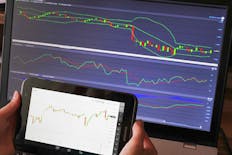The Learn to Trade Course: A Review (2025)
All products and services featured are independently selected by WikiJob. When you register or purchase through links on this page, we may earn a commission.
- A list of the Top Brokers for Trading in January 2025:
- Description of the Best Brokers for Trading in January 2025
- The Learn to Trade Course: A Review
- Course Content and Structure
empty
empty
empty
- Pros and Cons
empty
empty
empty
empty
empty
empty
empty
empty
- Frequently Asked Questions
- Final Thoughts
A list of the Top Brokers for Trading in January 2025:
Here are our top picks:
Description of the Best Brokers for Trading in January 2025
1. Plus500
Plus500 was founded in 2008, and is considered to be a high-trust broker because not only is it regulated by top-tier bodies like the FCA in the UK and ASIC in Australia, but it is also listed on the London Stock Exchange.
Plus500 offers CFDs, 71 forex pairs and stocks. You can trade using its proprietary platform, which is available as a desktop download, a web trader and a useful, well-designed and streamlined mobile app.
Deposits and withdrawals are fast and free, and you can use a bank transfer, eWallets, and credit or debit cards to fund your account.
The minimum deposit is quite high, however, at £100.
The trading fees are about average, so there is not too much cost involved with making trades or maintaining an account at Plus500.
Plus500 does not offer access to platforms like MetaTrader, but it does have a proprietary platform called Web Trader that is simple and easy to use with a range of charting options and trading tools.
However, for those who like a lot of research in their trading apps, Web Trader and Plus500 as a whole does not provide that much detailed information.
For beginner traders, Plus500 does have a demo account where you can practice trading without risking your own capital, and the Trading Academy has a reasonable amount of educational material in the form of videos, eBooks and articles.
There is also a Traders Guide which has some further learning resources.
2. Pepperstone
Pepperstone is consistently recognized as one of the best brokers for trading, particularly in the forex market.
Pepperstone is regulated by top-tier financial authorities, including the UK Financial Conduct Authority (FCA), the Australian Securities and Investments Commission (ASIC), and the Cyprus Securities and Exchange Commission (CySEC).
This robust regulatory oversight ensures a secure trading environment with safeguards like segregated client accounts and negative balance protection.
Pepperstone offers highly competitive spreads and low commission rates. For instance, the Razor account features spreads as low as 0.1 pips for major currency pairs like EUR/USD, with a $3.50 commission per lot per side.
This pricing structure is advantageous for strategies that rely on tight spreads, such as scalping and high-frequency trading.
The broker supports several leading trading platforms, including MetaTrader 4 (MT4), MetaTrader 5 (MT5), TradingView, cTrader and Pepperstone's own platform (depending on jurisdiction).
These platforms offer advanced charting tools, automated trading capabilities, and extensive technical analysis features, catering to both novice and experienced traders.
Pepperstone provides access to over 1,200 tradable CFD instruments, including 90+ forex pairs, commodities, indices, cryptocurrencies (depending on jurisdiction), shares, and ETFs. This diverse range allows traders to diversify their portfolios and engage in various markets from a single account.
The broker offers 24/5 customer support through various channels, including live chat, email, and phone. Pepperstone also has a comprehensive FAQ section and provides educational resources such as webinars and trading guides to support traders at all levels.
Pepperstone does not charge deposit fees and offers multiple funding options, including credit/debit cards, PayPal, Skrill, Neteller, POLi, USDT, Crypto, BPay, Union Pay and bank transfers (depending on your location). Withdrawals are processed quickly, with most methods being free of charge, although there may be fees for certain international bank transfers.
3. IG
IG invented spread betting in 1974 and today is the world’s leading online trading provider with more traders trusting them with their money than anyone else
IG is authorised and regulated by the FCA and provides traders access to over 18,000 markets. IG offers more 24-hour indices than any other provider, and extended hours on over 70 key US stocks
For those who prefer to own the underlying asset, IG offers access to over 13,000 global shares and ETFs, or a wealth portfolio managed by one of their experts.
Benefits:
- Advanced platform and charting – L2 dealer, ProRealTime and MT4
- Demo account
- Extended trading hours
- Extensive range of products
- Daily expert analysis & educational resources
- Round-the-clock customer service
- Negative balance protection for retail clients
Based on revenue (published financial statements, October 2022). 24/7 excludes the hours from 10 pm Friday to 8 am Saturday (UK time), and 20 minutes just before the weekday market opens on Sunday night.
The Learn to Trade Course: A Review
Set up in 2003 by the successful trader and entrepreneur Greg Secker, Learn to Trade is a well-established forex education provider operating on a global scale.
Its three-day forex trading course offers an introduction to the market, covering opportunity and risk, and provides students with an understanding of trading fundamentals and strategies.
This Learn to Trade review covers course content and structure and aims to give an unbiased overview of the education programme as a whole.
Learn to Trade has taught over 250,000 students worldwide and there are mixed reviews from past participants to be found online.
However, it should be noted that the majority of these are positive reviews, and the students that have gained the most from this course are those that have dedicated themselves to mastering the skill of forex trading.
Course Content and Structure
Before we dive into our Learn to Trade review, it should be noted that this course does come at a cost, so it’s important to make sure it’s right for you.
For those with little to no experience in forex, it’s advisable that you first take advantage of Learn to Trade’s free two-hour workshop.
These are held regularly at various locations across the UK and act as an introduction to the more comprehensive course discussed below.
The three-day course itself is usually held at Learn to Trade’s London office, though owing to the COVID-19 pandemic, the course has been moved online for the short term.
Once things return to normal, students will learn in a dedicated classroom with an adjoining live trading floor. All sessions are led by experienced tutors with professional trading experience.
Day One
The first day of the course is designed to take you through the fundamentals of forex trading.
You will:
- Learn basic terminology and be introduced to exchange rates
- Discuss topics including advanced price action and cyclicity, which form the basis of all technical analysis
- Cover common trading strategies
- Learn how to place a trade
Day one also includes an ‘emotional mastery’ section, guiding students through the principles of trading psychology.
This is an important aspect of all trading education. Learning how to handle emotions like the ‘fear of missing out’ is key to minimising potential losses.
Day Two
Day two becomes more hands-on and you’ll start with an introduction to the SmartCharts platform. This is the trading software you’ll use for the remainder of the course.
You’ll be introduced to its features and functionality, as well as how to use them with maximum efficiency to identify and execute successful trades.
The course then moves on to the five strategies Learn to Trade recommend for profitable forex trading:
- The 180 phase change
- Trend tracker
- Pip runner
- Volatility reversal
- Forex T-Wave
You’ll round off the day with a session on forex and the news, where you’ll learn the vital skill of predicting market movement based on global events, and will take an in-depth look at how to manage risk.
You’ll then complete your theoretical training by working on your own trading plan based on everything you’ve learnt over the previous sessions.
Day Three
The final day of the course allows you to put what you’ve learnt into practice on the live trading floor under the guidance of your tutors.
You’ll use your own trading account to execute real-time trades with your own funds.
Pros and Cons
As we mentioned at the start, this Learn to Trade review aims to offer an unbiased opinion of the course. With that in mind, here’s what we liked about it, and a few things that are worth being aware of:
Pros
- Experienced tutors
- Immersive training
- One-to-one tuition
- Tried and tested strategies
Cons
- Intensive learning environment
- SmartCharts focus
- The upsell
- Hidden costs
Pro: Experienced Tutors
One of the most important things to consider when choosing a forex training course is the professional experience of the provider.
You need to be sure that you’re learning from someone with demonstrable success in the field, particularly when you’re investing a large sum into your training.
Learn to Trade tutors come from a professional trading background and are trained to deliver the course content in a way that’s easy to understand for beginner students.
It’s also clear from the comments made by past participants that they do this with enthusiasm and keen attention to detail.
Pro: Immersive Training
Trading in any market comes with a high degree of risk so it’s vital to get to grips with the fundamental principles before you enter a live trading environment.
All good forex training courses will equip you with this knowledge, but Learn to Trade provides an immersive experience that combines theoretical knowledge with practical experience.
Having undertaken two days of intensive education, you’ll get to put theory into practice by placing live trades on the third and final day of the course. What’s more, you’ll have the support of professional traders on hand to guide you.
Pro: One-to-One Tuition
As part of the course package, you’ll get three one-to-one training sessions with a Learn to Trade tutor.
These can be organised at your convenience on completion of the course and can be used to address anything you feel you need more guidance on.
Learn to Trade clearly states that it takes commitment to become a successful forex trader, and the three-day course alone is not enough to take you from beginner to expert.
The one-to-one sessions are there to ensure you make the most of the course content and help you plot any future training, so be sure to take advantage of them.
Take a Asia Forex Mentor Trading Course
Pro: Tried and Tested Strategies
The focus of the Learn to Trade course is a set of strategies designed to offer the most profitable pathways in the forex market. These have been developed over time by Greg Secker, a lifestyle trader, and Learn to Trade itself, and so come with some repute.
Do remember, though, that there is no sure-fire way to make money from trading.
All trading is, essentially, a gamble, but by learning to implement tried and tested techniques, you can minimise risk and increase opportunity.

Con: Intensive Learning Environment
This could be seen as a positive since intensive training is by far the fastest way to start your forex journey. However, we’ve listed it as a con in our Learn to Trade review as some people aren’t suited to this fast-paced learning environment.
There’s a lot crammed into the two days of theoretical learning and if you’re someone who prefers to digest information at a slow pace, you might struggle to keep up.
That said, you will have access to educational resources before you start your course, so taking the time to review these thoroughly will be of huge benefit.
Con: SmartCharts Focus
SmartCharts is a charting software company also founded by Greg Secker, and it’s the platform you’ll use throughout the course.
The forex strategies you’ll be taught are all preprogrammed into the SmartCharts AI capability, making it easier for you to implement them.
This is great if you intend to stick with SmartCharts software moving forward and if you want to use an affiliate broker.
However, if you plan to shop around for your broker of choice, you should keep in mind that you’ll likely have to familiarise yourself with a new platform, like Meta Trader or NinjaTrader.
Con: The Upsell
Learn to Trade is a reputable education provider. It should be mentioned, though, that during your course you will be made aware of, and invited to join, its ongoing training programme, known as the Ultimate Wealth programme.
Critics cite this as a marketing ploy, as the Ultimate Wealth programme comes at a significant cost. However, Learn to Trade is a business and there’s absolutely no obligation to sign up for further education.
The Ultimate Wealth programme is designed for those that are serious about forex trading and are willing and able to make further financial investment to broaden their prospects.
If this is you, make sure you fully understand the risks and costs involved before making any kind of commitment.
Con: Hidden Costs
There are additional costs involved with the course beside the fee itself, which we’ll explain in the FAQs section of this Learn to Trade review.
There are some complaints around these from past students, but all associated fees are laid out in the full terms and conditions.
As with any kind of financial investment, which this course certainly is, it is imperative you read all the information available to you before paying your deposit, to avoid any unpleasant surprises.
Frequently Asked Questions
The exact amount of the course is not clearly advertised and will only be made apparent to you on application. This is because Learn to Trade often offers discounted prices and limited-time offers.
That said, our research suggests the common cost ranges between £2,000 and £3,000, which is relatively average for this type of comprehensive training.
If you attend the free forex workshop, you’ll be informed of current offers on the day, but make sure you’re fully committed to the programme before you pay your deposit as it is only partially refundable and there may be further costs involved.
As previously mentioned, the course itself consists of two days of theoretical training and a third day of practical experience, complemented by three one-to-one sessions.
In addition to this, you’ll receive an at-home study aide in the form of a video tutorial. You should digest this fully before your course commences as it discusses some basic terminology and gives an overview of the market.
You’ll also get lifetime access to the Learn to Trade Graduate website.
Again, make use of this before you start the course as it explains some essential information like how to open your trade account and set up the SmartCharts software.
When attending the course onsite, you’ll need to have a laptop, calculator and general stationery with you.
You’ll also need to have set up and funded a trading account, and have access to a charting package, which is where some of the hidden costs come into play.
As mentioned, your training will be conducted using the SmartCharts software, the platform through which you’ll learn to understand and execute trading strategies. As such, you’ll be required to pay a fee for this before you start.
You’ll also be making live trades on day three, so you’ll need to have funds in your trading account.
The exact fees for these are not listed on the Learn to Trade website, so do make sure you read the full terms and conditions or seek advice from the customer services team to get a full breakdown of costs before you join.
The best course for you can vary depending on what it is that you are looking for. Many people find that the Learn to Trade course offers them an intensive and immersive experience which allows them to learn about Forex and trading strategies.
For a large number of people the Learn to Trade course is worth it. They find that they are able to make better investments and increase their returns after using the Learn to Trade course.
No. Greg Secker offers a course which can potentially increase the returns potential of your forex trades. The effectiveness of this course will depend on how you implement the techniques.
There are many people who have bought the course and found that they have been able to increase their profits and returns.
The typical cost for this course is between $2,000 and $3,000 and there are often discounts and special offers available.
If you are a dedicated trader who is committed to advancing your journey into the world of Forex, then it is definitely worth considering the Learn to Trade course.
If you are unsure, then it is probably a good idea to take the free one-day workshop before deciding to commit to the full course.
Greg Secker uses SmartCharts software which is a platform he owns. This is also what you will use during the course.
Yes. The principles taught in the course can be applied to real life situations and have the potential to provide increased returns.
This doesn’t mean that profits are guaranteed, however, as trading is always risky and there is always the potential for losses.
The exact cost of the course can vary depending on special offers and discounts which may be available. It will usually cost between $2,000 and $3,000.
The Lifestyle Trader is a name given to Greg Secker.
Greg Secker is an entrepreneur who began his career within Thomas Cook Investments before moving on to become Vice President of Mellon Financial Corporation.
After leaving at the age of 27, he began developing the Learn to Trade course which teaches individuals the best ways to make the most of their investments.
He is also a motivational speaker and philanthropist.
Greg Secker is a British entrepreneur, trader, and speaker known for his involvement in the field of foreign exchange (forex) trading and financial education. He is the founder of Learn to Trade, a company that provides educational resources and training for individuals interested in trading forex and other financial instruments. Secker has gained prominence for his seminars and workshops on trading strategies and financial literacy.
Yes. Greg Seeker was wealthy before leaving Mellon Financial Corporation at the age of 27. Since then, he has built a fortune from sales of his course and other investments.
Final Thoughts
Learn to Trade has been helping students start their forex journey for 17 years and there are many success stories to be read from past participants online.
If you are dedicated to your forex education and understand that this comes at a cost, the course delivers an excellent standard of tuition and ongoing support.
Forex trading is not for everyone so we strongly advise anyone thinking about this or any other form of trading, to get a good understanding of what the market involves and all associated risks.
This is exactly what the free Learn to Trade forex workshop is designed for. It’s a way for students to establish if the market is right for them before committing to the paid-for programme.
WikiJob does not provide tax, investment or financial services and advice. The information is being presented without consideration of the investment objectives, risk tolerance, or financial circumstances of any specific investor and might not be suitable for all investors. Past performance is not indicative of future results. Investing involves risk including the possible loss of principal.





